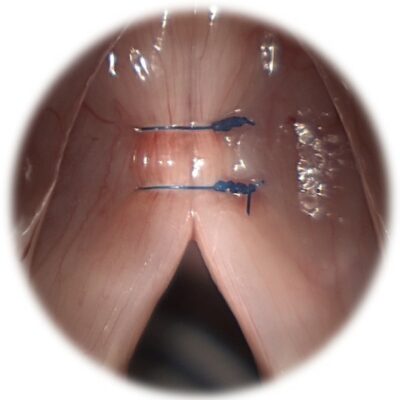Glottoplasty = Vocal Fold Webbing
The main goal of glottoplasty is to increase the fundamental pitch by tightening, shortening and/or thinning the vocal folds in a symmetrical manner. All three techniques lead purely physiologically to an increase in the vibration frequency of the vocal folds.
Under general anaesthesia, a metal tube (laryngoscope) is placed through the mouth to lift the tongue out of the way and visualize the vocal cords directly. Using a microscope, the lining of the vibrating portion of the vocal cords is removed from the front half of the vocal cords. The vocal folds are surgically shortened by anterior suturing and subsequent permanent union, so that a higher fundamental frequency is enforced in the posterior remaining, oscillating segment.
After this comes the most complex part of the voice feminization surgery where the 1/3th is sewed together with sutures, this is done with long instruments that reach from the outside. This is why it’s very important you have a skilled surgeon to do this.
Advantage:
No external incision, the procedure is done via the mouth
Cricothyroid muscle is untouched, so you can still train your voice flexibility (good for singing!)
Disadvantage:
It can take a long period of training before your voice will be back to normal. This is why voice therapy in is highly recommended.
Glottoplasty was invented by Juergen Wendler in 1989

30%-50% of the vocal folds are sutured together


Glottoplasty sutures (done by Prof. Markus Hess)

Modifications or additional interventions of Glottoplasty
VFSRAC (Vocal fold shortening with retroplacement of anterior commissure)
Vocal fold shortening with retroplacement of the anterior commissure (VFSRAC) is a three-factor modification surgery of three fundamental principles such as length, tension, and density of vocal folds for raising the pitch with an endoscopic approach. It could modify all three factors of vocal folds by using permanent suture material and suturing of thyroarytenoid muscle to the internal perichondrium of the subglottic portion of the thyroid cartilage; as a result, recreating the anterior commissure to transform the man’s vocal folds to woman’s new vocal folds.
LAVA (Laser-assisted voice adjustment)
Depending on the vocal fold volume, ablation is performed using the LAVA method. Surgery with mass reduction of the vocal folds requires a significant reduction in mass
-
Asymmetry: permanent hoarseness
-
Hoarseness and breathlessness if surgery is not successful
-
‘Mucosal tightening’: superior epithelial scar
Conclusion: not sufficient as sole surgery, but useful as additional procedure

